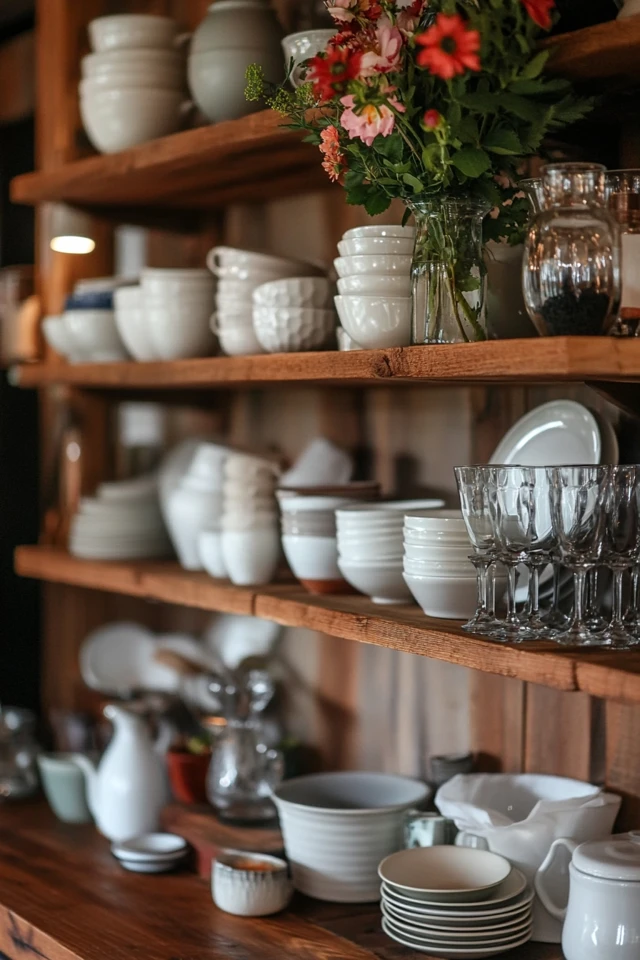Introduction
Open shelving in farmhouse kitchens is one of those design trends that’s both beautiful and functional. It creates an opportunity to showcase your personality, display cherished pieces, and make your kitchen feel open and airy. When I first decided to swap out my bulky upper cabinets for open shelves, I’ll admit, I was a little nervous. Could I really make it look as polished as the pictures I’d been drooling over on Pinterest? Would it still be practical for everyday use?
The answer was a resounding yes. With a little planning and the right mix of items, my open shelving not only transformed the look of my kitchen but also became one of my favorite parts of my home. The rustic wood shelves against the crisp white subway tiles gave my space that classic farmhouse charm, while the carefully chosen dishes, glassware, and decor added a personal touch. It turns out, styling open shelves is easier than I thought—and incredibly rewarding.
If you’re considering adding open shelving to your farmhouse kitchen or looking for tips to style the ones you already have, this guide is for you. From choosing the right shelves to creating a balanced display, I’ll walk you through everything you need to know to make your kitchen shelves a stunning focal point.
Why Open Shelving Works in Farmhouse Kitchens
1. Adds Visual Interest
Open shelves break up the monotony of closed cabinets, creating a more dynamic and inviting kitchen.
2. Showcases Personality
From heirloom dishes to handmade ceramics, open shelves allow you to put your favorite pieces on display.
3. Enhances Functionality
With everything within easy reach, open shelving can make your kitchen more efficient for everyday use.
4. Maximizes Space
Open shelves create the illusion of a larger kitchen by making the walls feel less heavy and cluttered.
Choosing the Right Shelving
1. Material Matters
The material of your shelves plays a big role in achieving that farmhouse look. Popular options include:
- Reclaimed Wood: Adds warmth and character with its natural imperfections.
- Whitewashed Wood: Lends a lighter, airy feel while maintaining a rustic vibe.
- Metal Brackets: Go for black or brushed steel brackets to add an industrial edge.
Pro Tip: If you’re on a budget, consider DIY-ing your shelves with inexpensive wood and a distressed finish.
2. Size and Placement
- Depth: Choose shelves that are at least 10–12 inches deep to accommodate plates and larger items.
- Length: The length will depend on your wall space, but longer shelves create a more dramatic effect.
- Spacing: Leave enough space between shelves (12–18 inches) to prevent the display from looking cramped.
How to Style Open Shelving
1. Start with a Clean Slate
Before you begin styling, clear everything off the shelves. This will help you visualize the space and make intentional design choices.
2. Choose a Color Palette
Sticking to a cohesive color palette ensures your shelves look polished rather than cluttered. Farmhouse kitchens typically feature neutral tones like:
- Whites and creams
- Soft grays and beiges
- Earthy accents like wood and green
Pro Tip: Use pops of color sparingly—like a few blue ceramics or green plants—to add interest without overwhelming the space.
3. Layer Textures
Mixing materials adds depth and dimension to your shelves. Consider incorporating:
- Ceramics: Plates, bowls, and mugs in neutral or muted colors.
- Glass: Clear jars or glasses for a touch of elegance.
- Wood: Cutting boards, trays, or small wooden decor pieces.
- Metal: Wire baskets or galvanized containers for a rustic edge.
4. Create Balance
The key to a well-styled shelf is balance. Avoid overcrowding one side or placing too many similar items together. Instead:
- Alternate between larger and smaller items.
- Use stacks of plates or bowls to create visual anchors.
- Leave negative space to prevent the display from feeling overwhelming.
5. Add Functional Elements
Your open shelves should be as practical as they are beautiful. Include items you use regularly, like:
- Everyday dishes and glasses
- Coffee mugs
- Canisters of dry goods (flour, sugar, pasta) in clear jars
Pro Tip: Label jars or containers with farmhouse-style stickers or chalkboard labels for a cohesive look.
Decor Ideas for Open Shelving
1. Greenery
Adding plants is one of the easiest ways to bring life to your shelves.
- Use small potted herbs like basil or rosemary for a functional and decorative touch.
- Opt for faux greenery if your shelves don’t get enough light.
2. Books
Cookbooks or vintage recipe books add charm and personality. Stack them horizontally for a more casual look.
3. Seasonal Touches
Rotate decor to match the season—think mini pumpkins in the fall, fresh blooms in the spring, or holiday garlands in the winter.
4. Farmhouse Signage
Small wooden signs with phrases like “Gather” or “Farm Fresh” are a quintessential farmhouse touch.
5. Baskets and Trays
Use woven baskets or wooden trays to corral smaller items like napkins or utensils while adding texture.
Picture Gallery
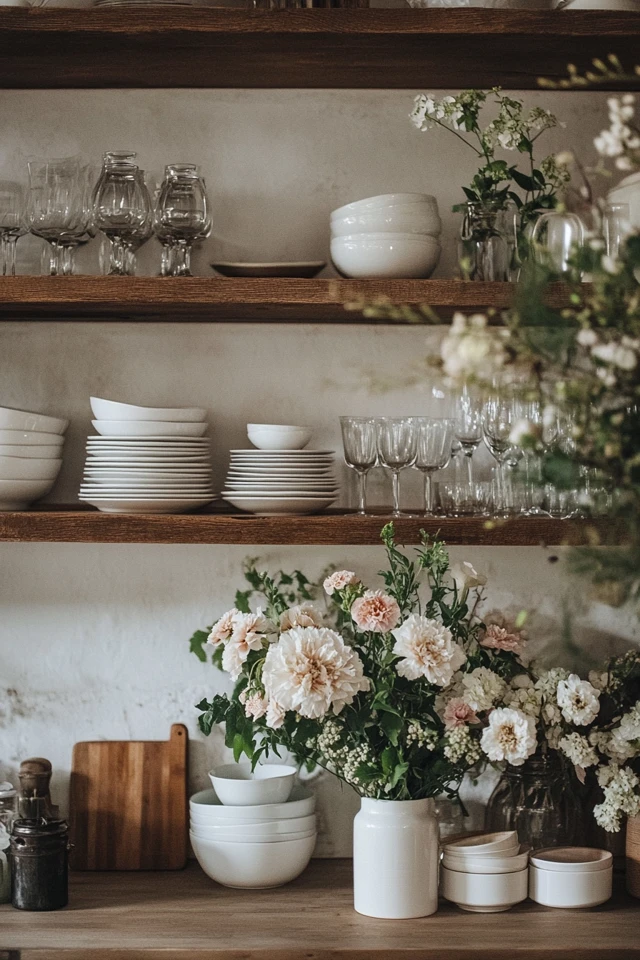
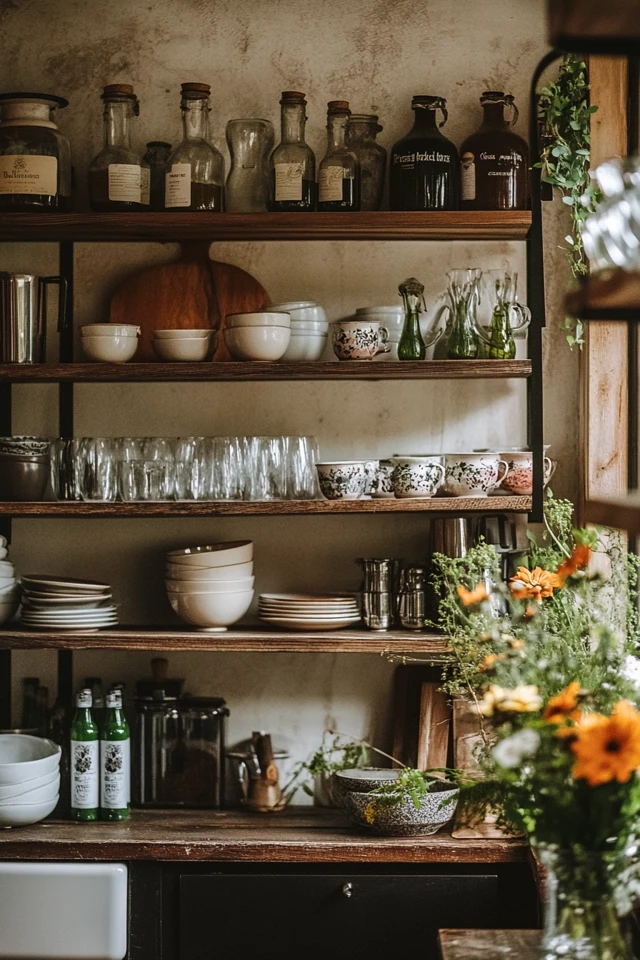
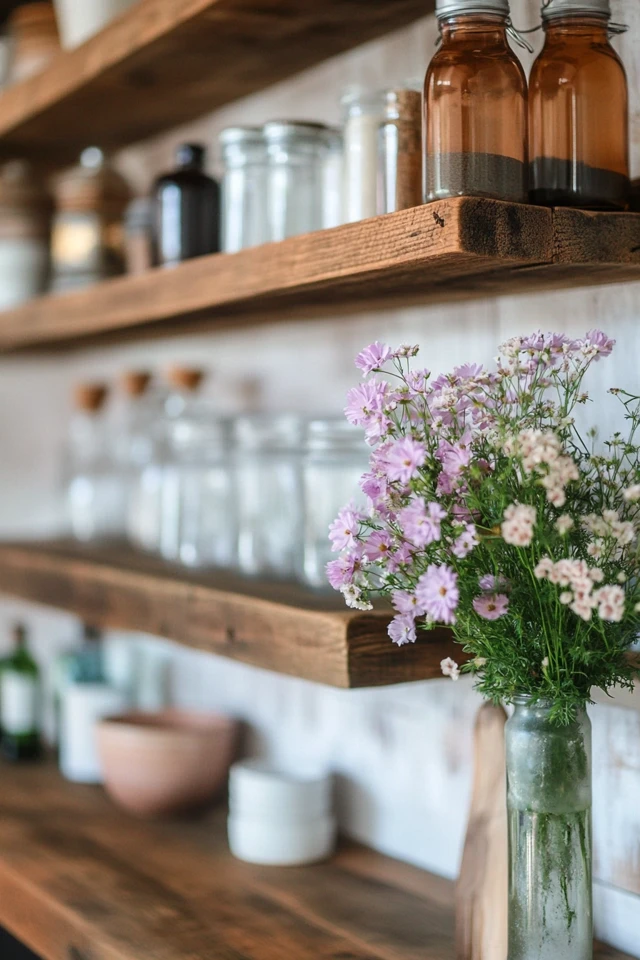
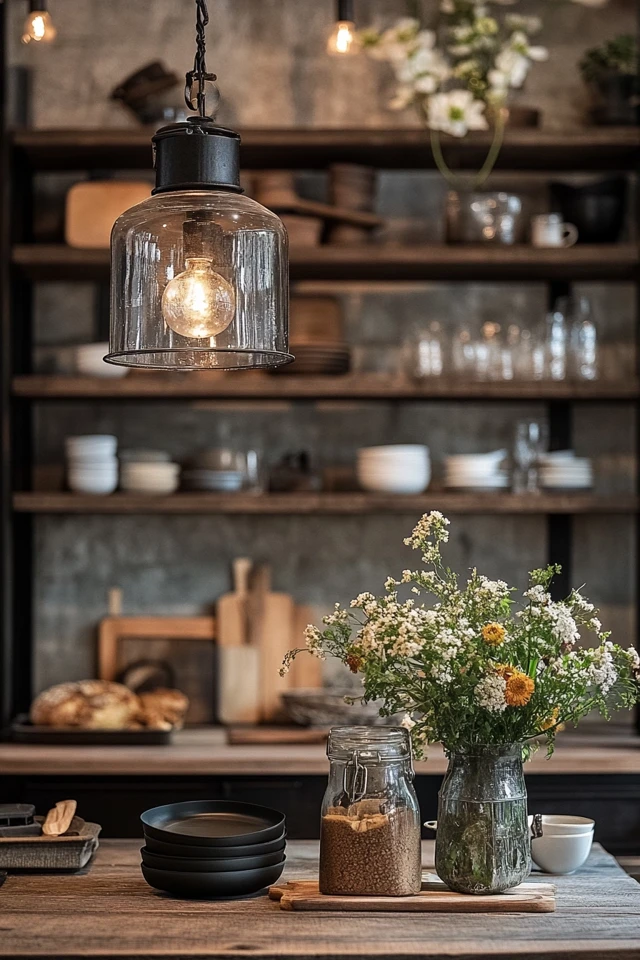
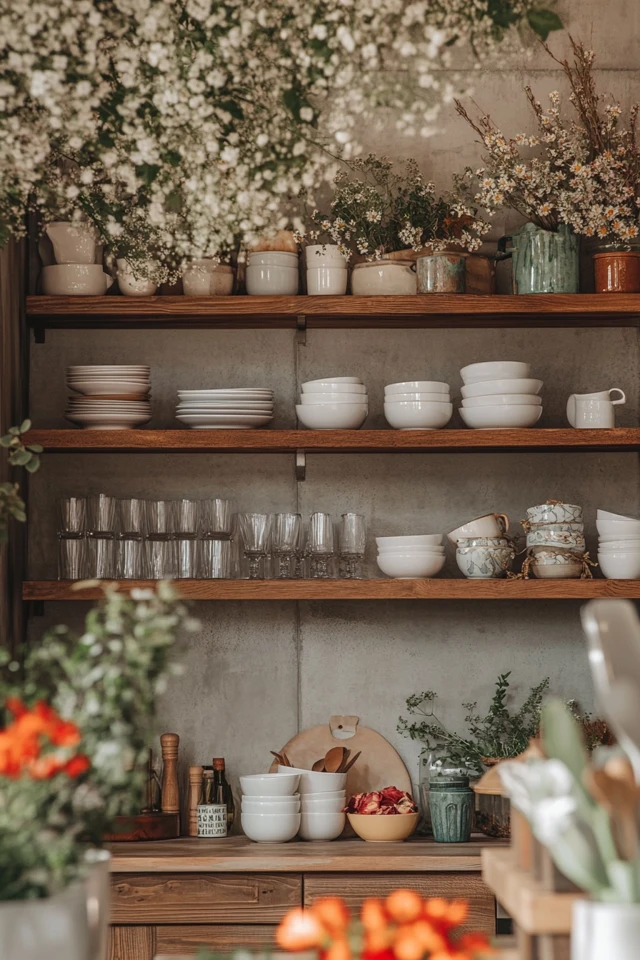
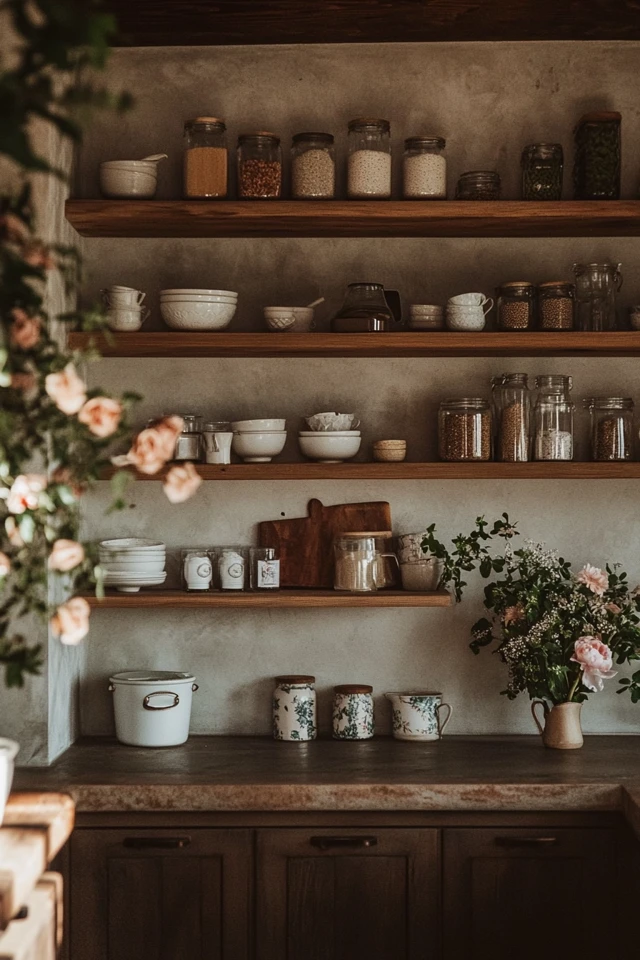
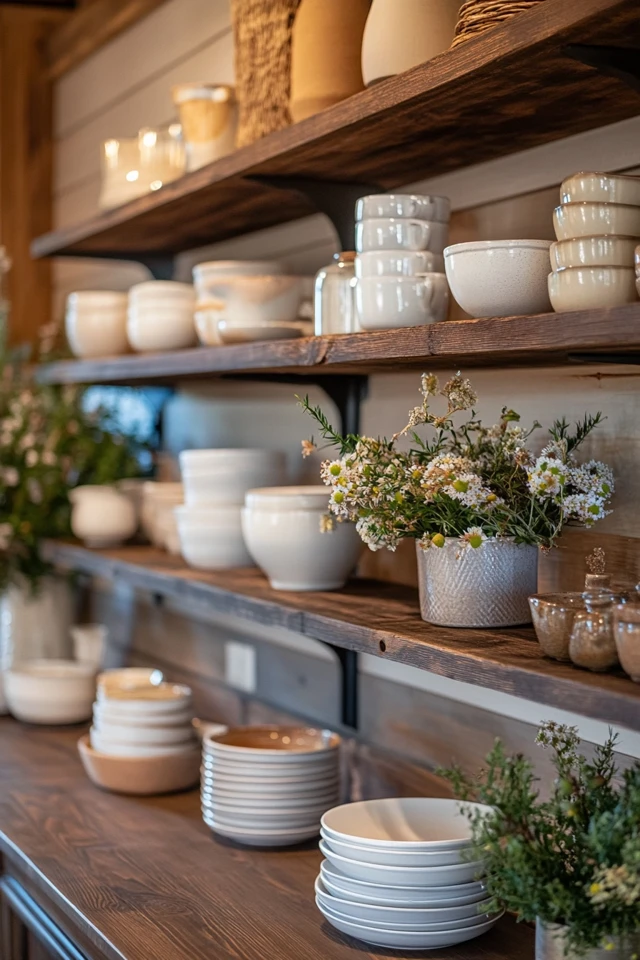
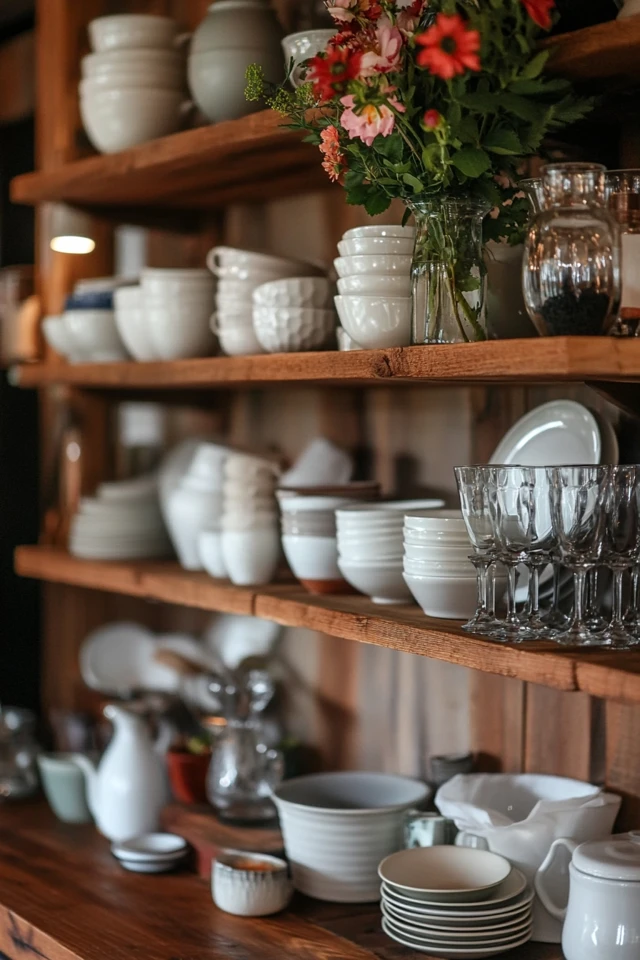
Mistakes to Avoid
1. Overcrowding
Less is more when it comes to open shelving. Leave some empty space to keep the look light and airy.
2. Ignoring Scale
Avoid placing items that are too large or too small for the shelves—they can throw off the balance of your display.
3. Skipping Functionality
While it’s tempting to focus solely on aesthetics, your shelves should still be practical. Keep everyday essentials within easy reach.
4. Neglecting Maintenance
Open shelves are prone to dust, so be prepared to clean them regularly to keep them looking their best.
Tips for Small Kitchens
If you’re working with a smaller kitchen, you can still make open shelving work for you:
- Use shorter shelves to avoid overwhelming the space.
- Stick to a minimalist color palette for a clean look.
- Prioritize functionality by displaying only the items you use most often.
Conclusion
Styling open shelving in a farmhouse kitchen is both an art and a science. With the right balance of form and function, your shelves can become a stunning focal point that enhances the overall charm of your space. For me, the process of styling my open shelves was one of the most rewarding parts of creating my dream farmhouse kitchen. It allowed me to showcase my favorite pieces, experiment with textures and colors, and truly make the space my own.
Whether you’re starting from scratch or refreshing your existing shelves, remember to have fun with it. Mix and match items, play with textures, and don’t be afraid to switch things up as your style evolves. With the tips in this guide, you’ll have beautifully styled shelves that perfectly capture the warmth and authenticity of farmhouse design.
FAQ
1. What materials work best for farmhouse open shelving?
Reclaimed wood is the most popular choice, but whitewashed wood and metal brackets are also great options for a farmhouse look.
2. How do I keep open shelving practical?
Display items you use regularly, like plates, mugs, and jars of dry goods. Store less-used items in nearby cabinets to avoid clutter.
3. How often should I clean open shelves?
Dust and clean your shelves every 1–2 weeks to keep them looking fresh, especially if you store frequently used dishes.
4. What’s the best way to add color to open shelving?
Use small accents like plants, cookbooks, or colorful dishes to add pops of color without overwhelming the neutral farmhouse palette.
5. Can open shelving work in a modern farmhouse kitchen?
Absolutely! Pair clean-lined shelves with industrial or minimalist decor elements to create a modern farmhouse aesthetic.

